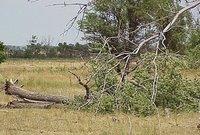
As any allergy sufferer knows, trees produce enormous amounts of pollen – a single tassel of birch flowers can disperse 10 million grains. March winds can bear the pollen of red maples, American elms, ashes, willows, and other early bloomers to fertilize distant flowers, leading to seeds and, if all goes well, a new tree.
The wind is a reliable, effective vehicle for arboreal intercourse. Some years ago, the Paris Botanical Garden had a pair of female pistachio trees that bloomed for years but never fruited. Then one year, both were full of nuts. A researcher found that some miles away, on the other side of the city, someone's new, male pistachio had bloomed for the first time that year.
While a high wind in March may spell the end for a few old trees, it can also bring life to many others.




No comments:
Post a Comment